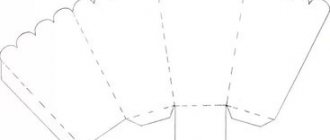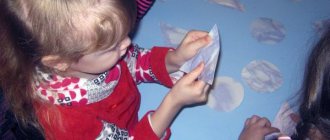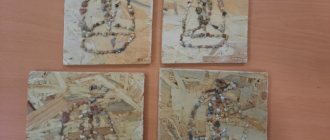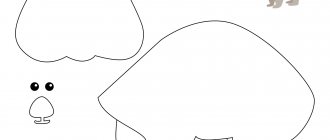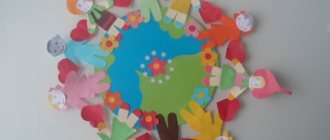Summary of a lesson on Lego construction for children 5-7 years old “The Evolution of Construction”
SUMMARY of organizing joint continuous educational activities with preschool children
Topic: Evolution of construction Age group:
children 5-7 years old
GCD form
: Lego construction technology
Subgroup
form of organization Educational and methodological set
: set of tasks “Construction machines” for the LEGO® designer set 45002, TRIZ technology
Means:
visual LEGO® set 45002 “Construction machines”, “Giant duplo set”, bricks from the LEGO SOFT set, axonometric projections of machine models, tables – system operator, pencils;
On the stand is a finished building with a construction site on which workers are located with a shovel, cart, concrete mixer, scraper, stepladder; multimedia presentation “Evolution of construction”, educational cartoon “Working machines for children”. OBJECTIVES of the educational program: Educational objectives:
• to develop the cognitive initiative of preschoolers in the process of generalizing ideas about construction machines through design;
• form ideas about the structure and history of machines; • develop logical thinking, promote the development of systems thinking; search for a problem and suggest ways to solve it; • develop cognitive interest and design skills based on images using a simple screwdriver; demonstrate the functions of the model and their management; Educational objectives:
• to develop cooperation skills in the process of joint activities;
• encourage the desire to independently search for knowledge and skills, develop the ability to invent games; • awaken curiosity, the ability to make decisions in accordance with the task, develop creative imagination, help acquire the skill of coordinated teamwork. In the technical dictionary
• Equilibrium • weight • experiment • distance Parts: chassis, wheels with tires, bucket, scraper, lever, boom Equilibrium An object is in equilibrium and does not move when all the forces acting on it are equal in magnitude and opposite in direction.
Fulcrum The point, or center, about which a lever, such as a lever, pivots or rotates. Vocabulary work: evolution, efficiency, equipment, design, architect, drawing, foundation pit, foundation, system operator, grader, milling cutter, asphalt paver. Expected result: 1. Ability to work in a team, carry out simple construction according to a model.
Developed ability to reason and debate. 2. Demonstration of curiosity, the ability to make decisions in accordance with the task, developed creative imagination. 3. Familiar with concepts such as bolted structures. The skill of designing from a drawing and axonometric projection is developed. 4. The ability to put forward your own hypotheses, assumptions, and describe the results. Children's creative activity and the experience they gain give them ideas for continuing research. Contents of the activity:
Stage 1 Establishing relationships (Goal setting) 1. Tower of Friendship. - In order for us to become more friendly, we need to assemble a tower. Look at the drawing, one-two-three - quickly start. Following the model in the presentation, children build a tower using Lego-soft blocks according to colors in teams of boys and girls - who is faster. Then they check for correctness. To quickly check the color sequence of a tower, you can turn one of the towers upside down. The towers will be the same.
2. Conversation: - What profession were you representatives of when you built your towers? — What other construction professions do you know? - What can’t you build a house without? (drawing, pit, foundation, equipment, building materials, construction site, specialists, equipment, etc.) - Were you now builders in our time or in ancient times? Express your assumptions and justify them. On the screen is an illustration of a construction site in ancient times.
3. Working with the system operator. (work cards)
— what item or tool is needed for each stage of construction? What if we are still in the past tense? Sketch it out schematically. 4. Using a presentation, we check the filling of each cell of the system operator (stage 1, start of construction - architect and drawing, stage 2, digging a pit - shovel and scraper, 3 - cart for transporting building materials, 4 - people to lay the foundation, 5 - concrete mixer , to pour the foundation, 6 – a stepladder to lay the bricks up.)
5. Determination of the problem when using such tools (long time, a lot of physical and human costs, ineffective). A suggestion on how to deal with the problem. A proposal to design equipment that will replace the unskilled labor of builders. 6. Moving in OUR TIME. (Dynamic pause). Teams are invited to build bridges from the past to the future from Lego soft, which would be durable, but raised above the floor. 7. A picture of construction in our time at the presentation.
Stage 2 Design (Creation of a model) 8. Creation of construction equipment from the construction set 45002 “Construction machines” in pairs. According to step-by-step drawings or according to a drawing in an axonometric projection.
Definition of the principle of working in pairs: one selects parts - the other builds; everyone assembles their own design, then they combine them; everyone assembles 2-3 stages in turn, etc.) - Without what will the machine not work? (engine, fuel, driver, wheels). Stage 3 Reflection (Discussion) 9. At the stand with a house and a construction site, you need to replace the outdated construction model with equipment that corresponds to the task being performed. 10. Filling out the second column of the system operator. (what equipment is needed at each stage of construction). Check your assumptions using ready-made answers in the presentation table.
Stage 4 Development (Transformation) Open end 11. Presentation: comparison of past and present construction methods. - What's better? – What is more effective? — What problems can arise in modern construction? 12. Self-esteem: - What surprised you? - What can you praise yourself for? - Why do you need this knowledge? — What else would you like to build, learn about mechanisms and devices for construction? 13. – What will the construction of the future look like? Dream at home and bring your drawings.
— Do you know what a milling cutter and asphalt distributor are? Where can I find out about this? I suggest you watch a film that tells about rare, but very necessary construction machines.
We recommend watching:
Lego construction for the development of speech in preschoolers A creative project for Lego construction in kindergarten. Senior group Regulations on holding a competition-exhibition on Lego construction and robotics for preschoolers Didactic game for developing computing skills in preschoolers
Similar articles:
Development of communication skills in design and research activities in preschoolers
Lesson summary “Getting to know Lego”
Early age group No. 1
Notes
“Getting to know Lego”
Educator: Rokhmistrova M.V.
2019
Goals:
Teach children how to build a building, repeating the teacher’s demonstration. Form ideas about size, shape, color. Develop fine motor skills and coordination of movements.
Vocabulary work:
constructor, cubes, bricks, turret, high, low.
Materials
: Container with Lego parts (cubes and bricks) in primary colors.
Surprise moment: Petya the parsley doll.
Petya: Hello, guys! I'm Petya! What's your name?
You have so much fun here, but I’m sad!
Educator: Why are you so sad? Have you been offended?
Petya: I wanted to build a high tower out of cubes, but I can’t do it. The cubes fall apart all the time, and the friends laugh.
Educator: Yes, Petya, you need to build a tower out of cubes very carefully, place the cubes evenly. And then you have to play carefully, otherwise they will fall apart.
And just for the guys today I prepared not ordinary bricks and cubes, but from Lego. Let's all take a good look at them together.
There are so many of them, there is enough in the box for everyone. They are colorful. Blue and red, yellow and green. What color is this brick, Egor? Julia, show me the red brick. (etc)
Children examine and name the colors of the construction set.
Educator: And these cubes also have fastenings, with their help the cubes are pressed tightly against each other and held firmly. See how I connected them, now try it yourself.
Together with the teacher, children look at the details of the construction set and try to connect them.
Physical education minute
Educator: Do you know, Petya, what high towers we can build? Guys, stand here in a circle. Let's show Petya what kind of high tower we will build (children raise their hands up and reach higher and higher). Like this one!
And now we have low turrets, like this. (squat and touch the floor with your hands) 2-3 times
Sit on the mat. Let's build!
Children build towers, the teacher helps them.
Peter. Wow, what a turret I got, strong and tall! What about you guys? Well done!
Breathing exercises.
I wonder if the wind blows, will the turret fall? I'll check now.
Help me guys! We need to get more air. Puff out your cheeks, make your lips into a tube and blow and release the air strongly.
The children and Petya try to blow on the turrets. Our turrets are not afraid of the wind, they are durable.
Peter. How well you taught me how to build! Now I will show my friends how I can build and teach them too. Thank you! Goodbye guys, I have to go home.
Summary of the Lego construction lesson “Getting Acquainted”
Lyubov Gurdyumova
Summary of the Lego construction lesson “Getting Acquainted”
Class. Lego. Acquaintance.
Goal: To develop spatial imagination, attention, memory.
Tasks:
1. Introduce in a playful way the basic elements of the LEGO constructor.
2. Learn to classify by shape, size, color.
3. Form concentration of attention
4. Develop creative thinking.
5. Develop the ability to interact with children and adults.
6. Train fine motor skills of your fingers.
Equipment: A box with small strips of paper, LEGO parts of different colors and shapes. Presentation. TV.
Progress of the lesson:
psychological mood.
Educator: Hello, guys! Today we will go on a journey. And a magic mirror will help us with this. Let's look into it.
The presentation is shown, a magic mirror appears on the screen, with the help of which children find themselves in the land of LEGO.
Educator: Guys, you saw what magic happens in the land of Lego. Let's try to create a magical Lego world in our group. Shall we try?
Then let's get started.
“Find parts of the same color”
Educator: I have a box with LEGO construction sets. You see a lot of detail here. Some are small, like this, this is a cube. More is a brick, even more is a big brick. Details of different colors. Each of you has a strip of paper on your tables, they are also different colors. You need to go to the box and find a part of the color that you have on the piece of paper. Do you understand the task? We approach the box one by one and take five parts of the desired color.
Educator: Well done! Everyone completed the task.
Now use your cubes to build a tower.
Well done! You made some wonderful towers!
connection of parts.
Educator: Guys, when building the tower you placed one cube on top of another. This method of connecting parts is called a stack, i.e. you stack a stack, one on top of the other!
And there are other ways to connect parts. This is a ladder connection, when one part is placed on another. So, take a look and try to make a ladder yourself. Well done!
An overlap connection, when we connect two parts with a third, like this. Try connecting your parts this way. Well done!
Fizminutka:
Children walked through the forest (walking in place)
We observed nature (we look around)
We looked up at the sun (raise our heads up)
And their rays warmed them. (showing the rays of the sun)
The text is pronounced, and the children perform accompanying movements.
Assemble the model from memory
The teacher shows the children for a few seconds a model assembled from 3-4 (or more) parts, and then removes it. Children assemble the model from memory and compare it with the sample.
Summarizing.
Educator: Guys, we traveled with you to LEGO country. Did you enjoy the trip? What do you remember most?
